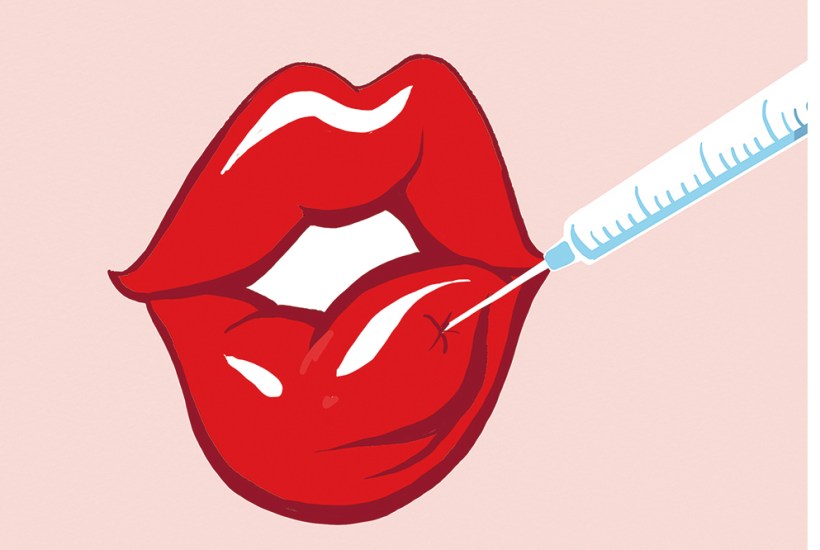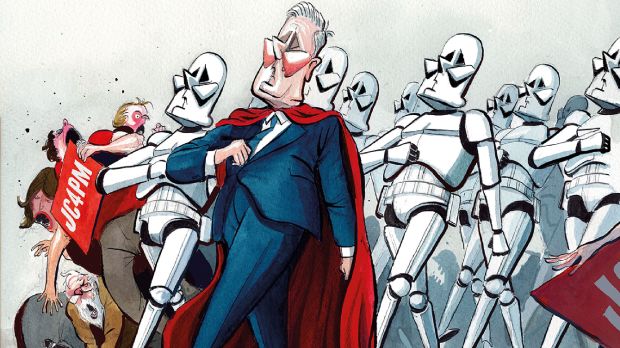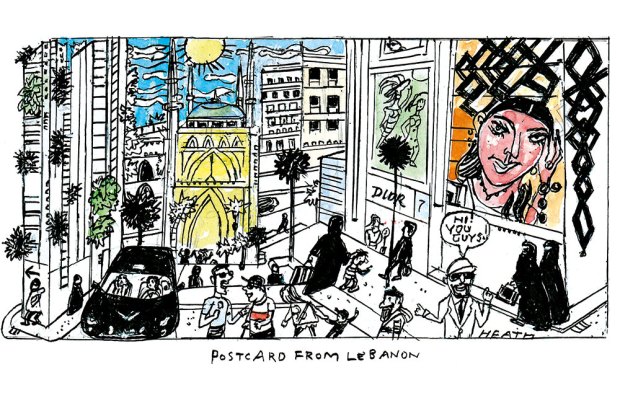If Barbie were a real woman, she wouldn’t be able to walk. Her enormous head would loll forward on her spindly neck, her tiny ankles would buckle under her elongated legs, and she would be forced to move about on all fours.
In the upcoming Barbie film, Margot Robbie nails her character’s toothy smile and blonde bouffant, but even she cannot come close to imitating Barbie’s monstrous proportions. More adventurous imitators have tried. It’s rumoured that the so-called ‘Eastern Bloc Barbie’ – a 37-year-old Moldovan by the name of Valeria Lukyanova, one of several plastic surgery addicts dubbed ‘human Barbies’ – had ribs removed and her eyelids trimmed in her efforts to look as much as possible like the real (or, rather, unreal) thing.
This is an extreme example, but what’s more worrying is the underlying trend. A generation brought up on social media, accustomed to projecting an idealised version of themselves, is buying into a certain ideal of beauty. In an era when editing photos of yourself is widespread, more people are starting to edit their actual selves with plastic surgery. Prices are crashing down: bigger lips from £200, a nose job for £3,500. The British Association of Aesthetic Plastic Surgeons (BAAPS) says that 600 cosmetic procedures a week were performed last year, twice as many as the previous year.
On the high street, adverts offering botox, liposuction and fat transfer are taking their place alongside offers of the perfect smile or year-long suntan. Nose jobs, breast augmentation and tummy tucks are joined by a new range of techniques popularised by influencers on Instagram and reality TV. The ‘Barbie nose’, according to one Turkish clinic targeting British customers, consists of ‘shaping a small, elegant nose with smooth curves and an otherworldly flare, as if coming from a fairytale fantasy or an anime creation’.
The fastest-rising procedure is the Brazilian butt lift, or BBL: it’s not offered on the NHS but is popular enough to be explained on the health service’s website. Fat is removed from one part of the body (the thighs or tummy) and the wound closed with stitches. Fat is then injected into the bottom, to smooth or enlarge. Such ‘fat transfer’ procedures cost between £2,000 and £8,000 in Britain with some 1,600 operations carried out last year in the UK – a rise of 36 per cent.
Plastic surgery and injectables are well on their way to becoming a normal middle-class pursuit, with many angling for the kind of work that – if done properly – should be almost invisible. ‘Pretty much everybody in the public eye who is 50 and above has had work done,’ says Andrew Jacono, an American cosmetic surgeon. ‘If you see a celebrity who is in her early to mid-fifties and still looks youthful, she’s had surgery.’
Most deny it, of course. The most pernicious manifestation of medical aesthetics is not the monstrous ‘human Barbies’ but those who enjoy a gentle tweak here and there, carried out during a lunch break and which can be easily denied. This has a far more profound effect on what we think of as normal – a trend reflected and amplified by reality TV. Two decades ago we had MTV’s I Want a Famous Face and Channel 4’s 10 Years Younger,which presented cosmetic surgery as part of a toolkit to look more like your idol or younger self. And it’s not only women: men now account for 7 per cent of cosmetic surgery.
The Kardashian sisters, who range from their late thirties to their mid-forties, are the queens of this new beauty ideal. They have popularised a kind of ethnically ambiguous look that can best be understood as akin to Coca-Cola: it artificially blends together only the most delicious components to produce something super-normally attractive. So we see the big bottom of a West African woman achieved through fat injections; the long thick hair of a South Asian woman achieved through extensions; the small nose of a Northern European woman achieved through rhinoplasty.
Gone are the days when Paris Hilton could cheerfully describe Kim Kardashian’s bum as ‘cottage cheese inside a big trash bag’. The market has decreed that waifishness is out and voluptuousness is in, and this look can be yours for the right price. Aesthetics clinics all over the UK advertise the ‘Kylie Jenner package’ (named for the Kardashians’ half-sister), which includes fillers in the lips, chin, jawline, cheeks and nose.
The most popular clinic in the Midlands is Clinique Modele Aesthetics, whose website shows several human Barbies having various work done. The contours of the lips can be edited to achieve an indent just under the nose, known as a ‘cupid’s bow’. It also offered a version of the BBL until Wolverhampton Council stopped it from doing so a few weeks ago, saying its staff lacked the expertise for such a delicate manoeuvre. It was the first time any council has cracked down in this way. The council pointed out that there’s no such thing as a BBL licence. Technology is advancing faster than regulators can keep up.
The cause for concern is pretty obvious. When BBLs go wrong they can be fatal – as many as one in 3,000 of the procedures carried out worldwide result in death. And it is, increasingly, a global market. Turkey is positioning itself as Europe’s leader, offering BBLs at about a third of the UK price. Some 1.2 million health tourists spent more than $2 billion in Turkey last year, according to the country’s national statistics agency – not just on cosmetic tweaks but on weight loss surgery, dentistry and other procedures with long NHS waiting times. Ushas, a state-owned Turkish healthcare company, has identified England as its top target market.
The NHS often ends up footing the bill for repair when foreign operations go wrong. BAAPS says one patient who went overseas for a BBL returned home with a flesh-eating bacterial infection that cost the NHS an estimated £47,000 to remedy. The highest-profile victim is Danniella Westbrook, a former EastEnders actress, whose facial surgery in Turkey went so wrong that she offered to pay the NHS £500,000 to put it right. The UK government estimates that 24 Britons have died when seeking treatment in Turkey in the past four years.
A strange feature of this 21st-century beauty ideal is that it is better suited to 2D. On the handful of occasions on which I’ve met famous internet beauties in the flesh, I’ve been surprised by the uncanniness of their appearance: skin too smooth, lips too plump. It turns out that Instagram faces look better on Instagram than they do in real life.
Which is not to say that these online celebrities have made a mistake in pursuing android beauty. There are fortunes to be made in the world of 2D, and projectable beauty has always been a hot commodity. There’s no end of research suggesting that people who are generally considered to be ugly suffer all kinds of adversity at disproportionate rates – more often passed over for promotion, more likely to struggle to make friends. A 2021 study found that when hospitality staff were forced to wear face masks during Covid, less attractive staff were regarded more positively by customers, while beautiful staff saw a drop in customer satisfaction. In other words, a wildly unequal playing field was temporarily levelled out.
Children are not just aware of this, but bombarded by it in the Instagram age. A 2021 study using American data shows an ‘exponential rise’ worldwide in teenagers as young as 15 seeking consultations for cosmetic procedures driven, it said, by an ‘obsession with physical appearance’. (There are no equivalent figures for the UK, where data is sporadic and the regulatory regime opaque.) You can see the logic: if being ugly is seen to be a nontrivial misfortune, becoming less so – or even beautiful – can radically improve a person’s life. In this way, every would-be Kardashian is behaving perfectly rationally: looking prettier can make it easier to secure the most desirable partners and professional opportunities. If it looks a bit odd in real life, that matters less to a generation who interact – and, in many ways, exist – more on screens.
If beauty is seen as something you can buy, not just something you’re born with, the result can be an arms race. We see botox is sold as being part of a girl’s make-up kit (‘No different from mascara and blush,’ said one advert). Every time a new example of beauty tech arrives on the market, it is seized upon by the Instagram influencers, who promote it to their millions of followers. Women suddenly find that a ‘normal’ beauty regime goes well beyond manicures and hair dye and now includes regular trips to a surgical theatre, at a cost of tens of thousands a year.
My own suspicion is that this effect is partly a consequence of constant exposure to images of extraordinarily beautiful women – images amplified by filters, as well as aesthetic treatments – which alter a girl’s perception of her own pool of so-called ‘intrasexual competition’. Put differently, girls of the past would have looked at their peer group and seen a bunch of normal kids just as chubby and acne-scarred as themselves. Now, they look at their screens and ask: ‘How can I compete?
In a way, Barbie harks back to a more innocent world where children played with dolls without ever thinking they could or should look like them. But teenagers are now growing up exchanging edited pictures of each other. They’re brought up in a world where aesthetics appear to be the key to everything: status, stature, friendships, prospects, worth.
We should expect the global medical aesthetics industry to go on ratcheting up, since there’s no reason for it to stop. My generation of millennials are already too far gone in the plastic fantastic world of Barbie beauty to have any hope of returning to a natural ideal.
But there is a lesson in here for the parents of adolescents, and particularly of girls. A growing cadre of parents are refusing to buy smartphones for their children, fearing the effects on their mental health. It was a trend that began in Silicon Valley among exactly the parents who were busy developing this tech in their professional lives.
Perhaps the digital-free cohort will grow up without feeling the need for a Barbie nose, or any other facial edits. But what we have right now is a generation that feels more judged and defined by aesthetics than any generation that has gone before it.
Got something to add? Join the discussion and comment below.
Get 10 issues for just $10
Subscribe to The Spectator Australia today for the next 10 magazine issues, plus full online access, for just $10.
You might disagree with half of it, but you’ll enjoy reading all of it. Try your first month for free, then just $2 a week for the remainder of your first year.














Comments
Don't miss out
Join the conversation with other Spectator Australia readers. Subscribe to leave a comment.
SUBSCRIBEAlready a subscriber? Log in